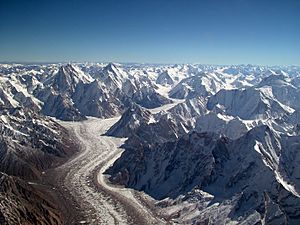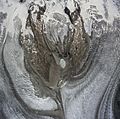Glacier facts for kids

A glacier is a huge, slow-moving river of ice and snow. Imagine a place where snow falls every winter, but it doesn't all melt away in the summer. Over many, many years, more and more snow piles up.
This huge pile of snow gets incredibly heavy. The weight of all that snow presses down on the layers below. This pressure is so strong that it squeezes the lower snow into solid ice. After hundreds of years, this giant mass of ice becomes so heavy that gravity starts to pull it.
Glaciers then begin to flow, but super slowly! They might only move about 50 metres (160 ft) in a whole year. It's like a frozen river creeping down a mountain or spreading across land. As parts of the glacier move away, new snow keeps falling to replace them. Glaciers are also super important because they hold the most fresh water on Earth, even more than all the lakes and rivers combined!
Contents
How Glaciers Are Made
Glaciers need two main things to form: very cold temperatures and lots of snow over a long time. It can take many decades, or even hundreds of years, for a glacier to grow big enough. There are two main types of glaciers you should know about:
Continental Glaciers
These are enormous sheets of ice that cover vast areas of land. Most continental glaciers formed a very long time ago during the Ice Ages. Today, you can still find massive continental glaciers in places like Greenland and Antarctica. When these huge glaciers reach the sea, pieces often break off. These floating chunks of ice are called icebergs.
Alpine Glaciers
Alpine glaciers are also known as mountain glaciers. They form high up in mountain ranges. These glaciers are usually smaller than continental glaciers. They flow down the mountain valleys until they reach a point where the air is warm enough to melt all the ice during the summer.
Why Glaciers Matter
Glaciers are super important for our planet. They are huge and heavy, so they have a big impact on the environment.
Shaping the Land
As glaciers slowly move, they act like giant bulldozers. They can erode (wear away) mountains and land, carving out valleys and shaping landscapes. This is why many mountain areas have unique U-shaped valleys.
Clues from the Past
Because glaciers freeze snow and air bubbles for thousands of years, they are like time capsules! Scientists can study the ice and air inside them to learn about Earth's past climate and atmosphere. It's like reading a history book written in ice.
Melting Glaciers
Recently, many glaciers around the world have been melting faster than they used to. Many scientists believe this is happening because of global warming, which is changing our planet's climate. This melting can affect sea levels and fresh water supplies.
What Color Are Glaciers?
Glaciers often look blue, especially deep inside or where the ice is very thick. This happens because water, and therefore ice, is really good at absorbing light. When sunlight hits a glacier, most colors of light (like red, yellow, and green) get absorbed. Only the strongest light, which is blue, can travel deep into the ice and bounce back out. The thicker the ice, the more blue it appears!
Images for kids
-
The glacier of the Geikie Plateau in Greenland.
-
Aerial view of a glacier in Chugach State Park, Alaska, United States of America.
-
Webber Glacier on Grant Land (northern Ellesmere Island) is an advancing polar glacier and frozen to the glacier bed. Debris rich layers of the ground moraine are sheared and folded into the ice. The steep icefront shows waterfalls. The glacier front is 6 km broad and up to 40 m high (July 20, 1978).
-
Shear or herring-bone crevasses on Emmons Glacier (Mount Rainier); such crevasses often form near the edge of a glacier where interactions with underlying or marginal rock impede flow. In this case, the impediment appears to be some distance from the near margin of the glacier.
-
Black ice glacier near Aconcagua, Argentina.
-
Fox Glacier in New Zealand finishes near a rainforest.
-
Glacial moraines above Lake Louise, Alberta, Canada.
-
South Cascade Glacier in Washington documented from 1928 to 2003 showing the recent rapid glacier retreating. By looking at this photo it's clear to see how quickly the glaciers are retreating in the modern world. This kind of retreating is the result of climate change which has significantly increased due to human impacts. This photo was taken from USGS U.S. Department of Interior research looking at the last 50 years of glacier change.
-
Northern polar ice cap on Mars.
-
Ice calving from the terminus of the Perito Moreno Glacier in western Patagonia, Argentina.
-
The Aletsch Glacier, the largest glacier of the Alps, in Switzerland.
-
The Quelccaya Ice Cap is the second-largest glaciated area in the tropics, in Peru.
-
Sightseeing boat in front of a tidewater glacier, Kenai Fjords National Park, Alaska.
-
A glacier cave located on the Perito Moreno Glacier in Argentina.
-
Crossing a crevasse on the Easton Glacier, Mount Baker, in the North Cascades, United States.
-
Glacier as seen by HiRISE under the HiWish program. Area in the rectangle is enlarged in the next photo. Zone of accumulation of snow at the top. Glacier is moving down valley, then spreading out on plain. Evidence for flow comes from the many lines on surface. Location is in Protonilus Mensae in Ismenius Lacus quadrangle.
See also
 In Spanish: Glaciar para niños
In Spanish: Glaciar para niños































